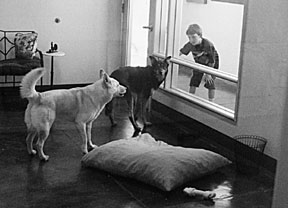by Kelly Gorman, CPDT
Many animal lovers in this country are aware of an epidemic that’s affecting our companion dogs and cats. There’s no easy cure; at best we can apply palliative measures. The epidemic? Rampant homelessness.
According to the Humane Society of the United States, 6 to 8 million dogs and cats enter shelters each year – and fully half of them are euthanized because they run out of time or are not considered adoptable.
Shelters are overworked, underfunded, and stretched thin in attempting to handle the influx of unwanted animals. They perform difficult and, at times, heroic work in caring for these dogs and cats. Often these animals have ended up in a shelter because they were not properly raised and trained by their owners.
Owner neglect varies greatly, from passive or unintentional neglect, such as not providing socialization or training for an active young dog, to active physical abuse. Either type of neglect can result in an animal that at best exhibits problem behaviors such as chewing, house soiling, or barking; or, at worse, becomes a menace to society. The ultimate outcome is often the same: abandonment or surrender of the troublesome animal – and the addition of yet another pet at a shelter.
Ironically, due to overcrowding, funding issues, personnel shortages, or just not knowing there is a better way, cats and dogs in many shelters are kept in conditions that do not meet the criteria outlined by the shelter for adoption to a new home. In other words, the shelter would not adopt one of their charges out to themselves, since they do not meet their own standards.
Many shelters house animals individually in stark kennels, often without comfortable bedding, appropriate toilet facilities or opportunities, toys, or companionship of their own kind. Most receive little human interaction, education, physical or mental stimulation. It is well known that:
• Solitary confinement causes progressive de-socialization and fearfulness
• Lack of toilet facilities, opportunities, and education forces cats/dogs to soil their living/sleeping areas
• Lack of stuffed chew toys prompts destructive chewing and obsessive-compulsive disorders
• Lack of stuffed chew toys and education prompts barking and hyperactivity (with allelomimetic encouragement)
• Well-meant but inappropriate exercise fosters hyperactivity, barking, jumping up, and leash-pulling
• House soiling, destructive chewing and/or scratching, excessive barking, hyperactivity, jumping up, and leash-pulling are reported as major reasons why people surrender their animals to shelters or let them stray (to be captured and taken to shelters).
The presence of these same behaviors is also a major reason why some people do not want to adopt shelter animals. Kenneling animals in the traditional fashion exacerbates such problems.
A new minimum
There are numerous and rigorous veterinary and physical health requirements for livestock and for laboratory and zoo animals. However, there are few requirements that cater to the animals’ social and psychological needs in a shelter setting. If shelter animals are to remain, or become, suitable social companions for people, they require comfort, companionship, communication, education, and entertainment.
As ambassadors for the humane treatment of animals across the nation, it is essential for shelters to place equal value on the mental and physical needs of the animals in their custody. Attention to an incarcerated animal’s mental well-being should not be an afterthought or a bonus, but on par with physical health concerns and part of the standard protocol for care.
Open Paw has created guidelines for “Minimum Mental Health Requirements for Shelter Animals” to serve as a model for shelters interested setting an example for the community by providing holistic care for their residents.
Open Paw’s vision for shelters is to raise the bar for basic domestic animal care, as well as to serve as a model for the public. Adopting Open Paw’s Minimum Mental Health Requirements (MMHR) and practicing efficient animal-friendly and user-friendly techniques for basic care and training of the shelter animals has a tremendous impact on the community. Everyone who enters the shelter observes firsthand that animal care and training can be simple, humane, and enjoyable.
Imagine: A prospective adopter walks into an animal shelter that is quiet and smells clean. The dogs are peacefully lounging on beds, happily chewing away on food-stuffed chew toys, or sitting calmly at the front of their kennels wagging “hello” at every passerby. The cats are either curled up in beds on elevated platforms or batting at dangling catnip toys. Volunteers are busily training dogs throughout the facility and cat cuddlers are patiently teaching young, playful cats to retract their claws before getting overexcited. This is the type of shelter that people travel for miles to visit, clamoring to adopt the friendly, well-trained residents. These are cats and dogs that will easily settle into their new, permanent homes.
At first glance, some of the recommendations may seem unfeasible or too labor-intensive to implement. However, following the MMHR and adopting the Open Paw volunteer training program actually reduces the amount of time required for husbandry, kennel cleaning, and upkeep. This allows staff and volunteers to spend time on the more gratifying goal of interacting with and training the resident animals.
For example, by providing access to a separate, appropriate toilet area for dogs (rather than forcing them to soil their kennels), hours of unpleasant daily manual labor is virtually eliminated. Also, toilet-trained animals are cleaner and more adoptable, meaning a shorter stay at the shelter.
Certainly Open Paw’s guidelines require a considerable paradigm shift, and of course there are initial growing pains and adjustments, but the transformation is magical. Once staff and volunteers see calm, contented, and mannerly cats and dogs, they become very eager and excited about participating in the program.
Win/win/win
Shelters that have adopted Open Paw’s MMHR have found that the noise level in the shelters goes down, which, in turn, helps attract and retain volunteers. Potential adopters see dogs who are clean and exhibit calm, friendly behavior; these dogs are many times more likely to be taken home than dogs who have stepped in their own feces as they whirl around and bark. Shelters that adopt and utilize the MMHR are able to offer more adoptable dogs – ones that have the least chance of “flunking” life in their new homes and being returned to the shelter.
What’s more, using the examples of the calm, well-behaved dogs in their kennels, shelter staff and volunteers can take the opportunity to educate prospective owners about the improved dog-keeping practices, to encourage the owners to use similar guidelines at home to maintain their new dogs’ mental health and good behavior. It’s a win for everyone.
-Kelly Gorman, CPDT, is the president and chairperson of Open Paw. To comment or to obtain more information on how Open Paw can help raise the standard of humane care in shelters, call phone (510) 644-0729, see www.openpaw.org, or e-mail kellyg@openpaw.org.







The shelter were i adopt my dog they have a lot of animals..